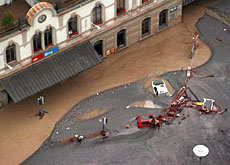Test house gets all shook up

For the first time ever in Switzerland, scientists have simulated the effects of an earthquake on a normal family home.
The test house – built before earthquake protection standards were introduced – proved to be more resistant to vibrations than expected.
We are on the upstairs floor of a typical Swiss house in Monthey, canton Valais. This mountainous area is the most at risk from earthquakes in Switzerland.
Nobody lives here anymore. The windows are smashed in and the rooms empty – apart from a few machines and countless cables and hoses scattered across the floor.
Suddenly the house begins to shake. The movements are visible. So this is what an earthquake feels like? Like being on a fishing boat rocked by the motor vibrations?
But this place is built on solid land, and it’s moving – not very reassuring.
Moving and shaking
Two machines known as shakers – normally used to test the resistance of bridges and dams – are making the house shimmy. Together they can replicate the effects of an earthquake measuring three on the Richter scale.
Olaf Huth of the Swiss Federal Laboratories for Materials Testing and Research is responsible for this first field test.
“We are trying to find out at which frequency the building vibrates to amplify the effects [of our machines],” he explained to swissinfo.
Different measuring instruments feed data continuously into a computer. The idea is to assess the house’s ability to stand firm when an earthquake strikes and perhaps find out more about how horizontal forces affect buildings in a tremor.
Less damage
“By shaking the house within its frequency range we can come closer to our aim of damaging the building,” said Huth.
But reality is somewhat different. The family home, built in the 1960s before earthquake regulations came into force, refuses to budge as the machines are cranked up to full power.
The stability of a house depends on its ability to absorb heavy shocks. According to preliminary measurements, the building in Monthey is tougher than most.
“We can say this house is relatively resistant to the effects of an earthquake,” admitted the project leader.
In fact it was judged so safe that journalists were allowed to observe the experiment from inside and without head protection. “But please don’t conclude that all older houses are as safe,” warned Huth.
Inadequate protection
This is an important point for the researchers. They claim that almost 90 per cent of Swiss houses were built before 1970 and are therefore inadequately protected against earthquake risk.
The object now is to strengthen houses that could be at risk of collapse.
“These buildings have to be tested,” said Masoud Motavalli, a professor at the materials testing and research laboratories. “Particularly important structures like schools, fire stations or hospitals.”
In some cases the addition of reinforced concrete walls or earthquake insulation has been enough to strengthen these old buildings adequately.
Use in earthquake areas
Motavalli, who comes from Iran, has knowledge of both Swiss building standards and those in Iran and Pakistan.
“There are relatively big differences, for example in the strength of the concrete used,” he said. In Switzerland the concrete is usually much stronger.
An even bigger difference can be seen in the stonework, where the mortar that holds the stones together is a problem in Iran and Pakistan.
“It is much weaker than the cement we use. It is often clay-based and doesn’t have much strength,” Motavalli told swissinfo.
One of Motavalli’s assistants is now working in Teheran to pass on Swiss knowledge and hopefully limit future earthquake damage. The results of this latest test in Monthey will also be forwarded.
Despite its solid Swiss construction, there will be no escape for the house, though. Huth wants to have another crack at it, this time using bigger machines.
swissinfo, Christian Raaflaub in Monthey
Before 1970 Swiss buildings were not designed to withstand earthquakes.
In 1970, the first earthquake related building regulations came into effect.
Broader regulations came into effect in 1989.
Strong earthquakes in Pakistan and India have served as a reminder that Switzerland is also prone to quakes, although on a smaller scale.
Researchers from the Swiss Federal Laboratories for Materials Testing and Research now want to gather more information on the earthquake resistance of the typical Swiss home.
To this end they used two “shakers” to simulate the effects of a tremor on a house in Monthey, canton Valais.

In compliance with the JTI standards
More: SWI swissinfo.ch certified by the Journalism Trust Initiative












You can find an overview of ongoing debates with our journalists here . Please join us!
If you want to start a conversation about a topic raised in this article or want to report factual errors, email us at english@swissinfo.ch.